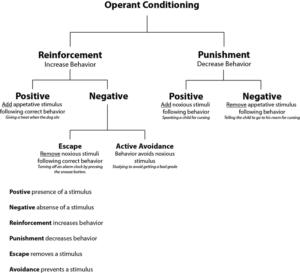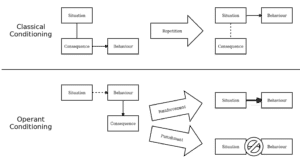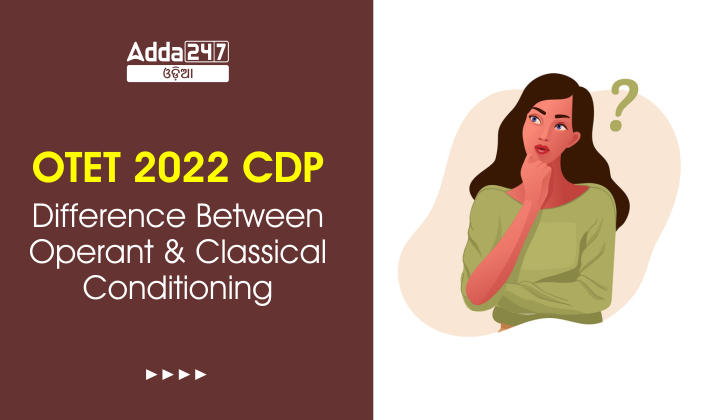OTET 2022 CDP Difference Between Operant and Classical Conditioning: We have provided Complete Notes on Child Development and Pedagogy Study Notes For OTET 2022 Exam. In view of your need, we have listed the Difference Between Operant and Classical Conditioning study notes for you.
Definition Classical Conditioning
Classical Conditioning: ଶାସ୍ତ୍ରୀୟ କଣ୍ଡିସନିଂ କିମ୍ବା ଉତ୍ତରଦାତା କଣ୍ଡିସନର ହେଉଛି ଏକ ଶିକ୍ଷଣ କୌଶଳ ଯେଉଁଥିରେ ପରୀକ୍ଷକ ଦୁଇଟି ଉତ୍ସାହ ମଧ୍ୟରେ ସମ୍ପର୍କ ଶିଖନ୍ତି, ଯାହା ପ୍ରାକୃତିକ ପ୍ରତିକ୍ରିୟା ପୂର୍ବରୁ | ଏହା ସୂଚିତ କରେ ଯେ ଗୋଟିଏ ଉତ୍ସାହର ଘଟଣା ଅନ୍ୟର ସମ୍ଭାବ୍ୟ ଘଟଣାକୁ ସଙ୍କେତ ଦେଇଥାଏ |ଏହାର ସବୁଠାରୁ ପ୍ରସିଦ୍ଧ ଉଦାହରଣ ହେଉଛି ପାଭ୍ଲୋଭଙ୍କ କୁକୁର, ଯେଉଁଠାରେ ଇଭାନ୍ ପାଭ୍ଲୋଭ୍ କୁକୁରମାନଙ୍କୁ ଏକ ମେଟ୍ରୋନୋମ୍ ଧ୍ୱନିରେ ଲାଳ ଦେବା ପାଇଁ ତାଲିମ ଦେଇଥିଲେ | ମେଟ୍ରୋନୋମ୍ ଏକ ନିରପେକ୍ଷ ଉତ୍ସାହ ଥିଲା, କାରଣ କୁକୁରମାନେ ଏହା ଉପରେ କଣସି ପ୍ରତିକ୍ରିୟା କରିନଥିଲେ | ପାଭଲୋଭ ପ୍ରତ୍ୟେକ ଥର କୁକୁରମାନଙ୍କୁ ଖାଇବାକୁ ଦିଆଯିବା ପରେ ମେଟ୍ରୋନୋମ ବ୍ୟବହାର କରିବେ ଏବଂ କୁକୁରମାନେ ଖାଦ୍ୟ ସହିତ ଶବ୍ଦକୁ ଯୋଡିବାକୁ ଲାଗିଲେ | ସାଲାଇଭେଟ୍ ହେଉଛି ସେମାନଙ୍କର ସର୍ତ୍ତମୂଳକ ପ୍ରତିକ୍ରିୟା | ଶାସ୍ତ୍ରୀୟ କଣ୍ଡିସନର କିଛି କାରଣ ଉପରେ ଆଧାରିତ ଯାହା ହେଉଛି:
- ଉତ୍ସାହ ମଧ୍ୟରେ ସମୟ ସମ୍ପର୍କ |
- ସର୍ତ୍ତମୂଳକ ଉତ୍ସାହର ପ୍ରକାର, ଯଥା ଘୃଣ୍ୟ କିମ୍ବା ଭୋକ |
- ସର୍ତ୍ତମୂଳକ ଉତ୍ସାହର ତୀବ୍ରତା |
Definition Operant Conditioning
Operant Conditioning: ଅପରେଟର୍ ଜୀବଜଗତର ନିୟନ୍ତ୍ରିତ, ସ୍ୱେଚ୍ଛାକୃତ ପ୍ରତିକ୍ରିୟା କିମ୍ବା ଆଚରଣକୁ ବୁଝାଏ | ଅପରେଣ୍ଟ ମାଧ୍ୟମରେ ଶିଖିବା ପାଇଁ ଅପରେଟ କଣ୍ଡିସନର କୁହାଯାଏ | ଏଠାରେ, ଜଣେ ବ୍ୟକ୍ତିର ପ୍ରତିକ୍ରିୟା ପରବର୍ତ୍ତୀ ସମୟରେ ଘଟୁଥିବା ପରିଣାମ ଉପରେ ନିର୍ଭର କରେ | ଅନ୍ୟ ଅର୍ଥରେ, ଏହା ଶିକ୍ଷାର ଏକ ସରଳ ପ୍ରକ୍ରିୟା ଯେଉଁଥିରେ ଫଳାଫଳକୁ ନିୟନ୍ତ୍ରଣ କରି ପ୍ରତିକ୍ରିୟାର ସମ୍ଭାବନା ବଝିଥାଏ | ଏହା ସାଧାରଣତ କର୍ମଜୀବୀ ପ୍ରେରଣା ସିଦ୍ଧାନ୍ତର ବ୍ୟବହୃତ ହୁଏ | B.F.ସ୍କିନର୍ ଅପରେଣ୍ଟ୍ କଣ୍ଡିସନରର ସିଦ୍ଧାନ୍ତ ପ୍ରସ୍ତାବ ଦେଇଥିଲେ ଏବଂ ସେ ସିଦ୍ଧାନ୍ତର ବିକାଶ ପାଇଁ ଏକ ମୂଷା ସହିତ ଏକ ସରଳ ପରୀକ୍ଷଣ ବ୍ୟବହାର କରିଥିଲେ | ପରୀକ୍ଷଣରେ, ଏକ ଭୋକିଲା ମୂର୍ତ୍ତିକୁ ଏକ ବାକ୍ସରେ ରଖାଯାଏ | ମୂଷା ଅନୁସନ୍ଧାନ କଲାବେଳେ ଏହା ଏକ ଲିଭର ଆବିଷ୍କାର କଲା | ଯେତେବେଳେ ଏହା ଲିଭରକୁ ଠେଲିଦିଏ, ସେତେବେଳେ ଏହା ଖାଦ୍ୟ ପାଇଥାଏ | ସମୟ ସହିତ, ମୂଷା ଖାଦ୍ୟ ଗ୍ରହଣ କରିବାକୁ ଲିଭରକୁ ଠେଲିବାକୁ ଶିଖେ |ଅପରେଟ କଣ୍ଡିସନରର ନିର୍ଣ୍ଣୟକାରୀମାନେ ଯେପରି:
- ଏକ ସଶକ୍ତିକରଣ, ଯଥା ପରିଣାମ |
- ପ୍ରତିକ୍ରିୟା କିମ୍ବା ଆଚରଣର ପ୍ରକୃତି |
- ପ୍ରତିକ୍ରିୟା ଏବଂ ଦୃଷ୍ଟିକରଣର ସମୟ ବ୍ୟବଧାନ |

Difference between Operant and Classical Conditioning
- ଶାସ୍ତ୍ରୀୟ କଣ୍ଡିସନିଂ ହେଉଛି ଏକ ପ୍ରକାର ଶିକ୍ଷଣ, ଯାହା ଦୁଇଟି ଉତ୍ସାହ ମଧ୍ୟରେ ଆସୋସିଏସନକୁ ସାଧାରଣ କରିଥାଏ, ଯଥା ଗୋଟିଏ ଅନ୍ୟର ଘଟଣାକୁ ସୂଚିତ କରେ | ଅପରପକ୍ଷେ, ଅପରେଣ୍ଟ କଣ୍ଡିସନିଂ କହିଛି ଯେ ଅତୀତର ଆଚରଣ ପରେ ଏହାର ପରିଣାମ ହେତୁ ଜୀବଜନ୍ତୁମାନେ ଏକ ନିର୍ଦ୍ଦିଷ୍ଟ ରଙ୍ଗରେ ଆଚରଣ କରିବାକୁ ଶିଖନ୍ତି |
- ଶାସ୍ତ୍ରୀୟ କଣ୍ଡିସନରରେ, କଣ୍ଡିସନର ପ୍ରକ୍ରିୟା ଯେଉଁଥିରେ ପରୀକ୍ଷକ, ଏହା ପୂର୍ବରୁ ଘଟୁଥିବା ଅନିଚ୍ଛାକୃତ ପ୍ରତିକ୍ରିୟା ଆଧାରରେ ଦୁଇଟି ଉତ୍ସାହକୁ ଯୋଡିବାକୁ ଶିଖନ୍ତି | ଅପରପକ୍ଷେ, ଅପରେଟିଭ୍ କଣ୍ଡିସନରରେ, ପରବର୍ତ୍ତୀ ପରିଣାମ ଅନୁଯାୟୀ ଜୀବଙ୍କ ଆଚରଣକୁ ପରିବର୍ତ୍ତନ କରାଯିବ |
- ଯେତେବେଳେ ଏହା ବିନା ସର୍ତ୍ତମୂଳକ ଉତ୍ସାହର ଘଟଣା ବିଷୟରେ ଆସେ, ଏହା ପରୀକ୍ଷକ ଦ୍ୱାରା ନିୟନ୍ତ୍ରିତ ହୋଇଥାଏ, ଏବଂ ତେଣୁ ଜୀବ ଏକ ନିଷ୍କ୍ରିୟ ଭୂମିକା ଗ୍ରହଣ କରିଥାଏ | ଏହାର ବିପରୀତରେ, ସଶକ୍ତିକରଣର ଘଟଣା ଜୀବଙ୍କ ନିୟନ୍ତ୍ରଣରେ ଅଛି ଏବଂ ଏହିପରି, ଜୀବ ସକ୍ରିୟ ଭାବରେ କାର୍ଯ୍ୟ କରେ |
- ଶାସ୍ତ୍ରୀୟ କଣ୍ଡିସନର ଅନିଚ୍ଛାକୃତ କିମ୍ବା ପ୍ରତିଫଳିତ ଆଚରଣ ଉପରେ ନିର୍ଭର କରେ, ମୂଳତ, ଜୀବ, ଶାରୀରିକ ଏବଂ ଭାବଗତ ପ୍ରତିକ୍ରିୟା ଯେପରିକି ଚିନ୍ତା, ଭାବନା ଏବଂ ଭାବନା | ଅନ୍ୟ ଚରମ ଉପରେ, ଅପରେଟ କଣ୍ଡିସନର ହେଉଛି ଏକ ଯାହା ସ୍ବେଚ୍ଛାକୃତ ଆଚରଣ ଉପରେ ଆଧାରିତ, ଯଥା ଜୀବଙ୍କ ସକ୍ରିୟ ପ୍ରତିକ୍ରିୟା |

Difference Between Operant and Classical Conditioning : FAQ
Q1. The conditioned stimulus gets its reinforcing power from association with the
Ans. Unconditioned stimulus
Q2. Behavior pattern that increases in frequency when followed by a reward is known as
Ans. Operant conditioning, sometimes referred to as instrumental conditioning, is a method of learning that employs rewards and punishments for behavior. Through operant conditioning, an association is made between a behavior and a consequence (whether negative or positive) for that behavior.
Q3. In Skinner’s view secondary reinforces are derived when associated with
Ans. Skinner is regarded as the father of Operant Conditioning, but his work was based on Thorndike’s (1898) law of effect. According to this principle, behavior that is followed by pleasant consequences is likely to be repeated, and behavior followed by unpleasant consequences is less likely to be repeated
Q4. A person rattles the box of dog’ biscuits before giving the biscuit to dog. As the person rattles the box the dog begins to salivate. Thus rattling of box is . . . . . . . . . . . . ; and the salivation of dog is a kind of . . . . . . . . . . . . . .
Ans. CS : CR
Q5. Learning of fears is best explained by :
Ans. Fear conditioning is a form of classical conditioning, the type of associative learning pioneered by Ivan Pavlov in the 1920s.
| Read More Information |
| OTET 2022 CDP – Kothari Commission(1964-66) |
| OTET 2022 Child Development And Pedagogy – NCF 2005 |
| OTET 2022 Child Development And Pedagogy – Stages Of Teaching |











